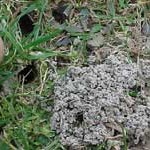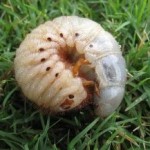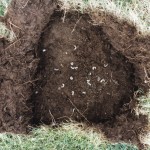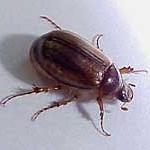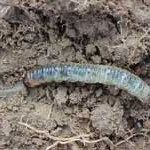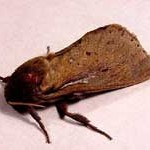Grass grub time…
Gardeners are always complaining about their lawns being damaged by grubs which include Grass Grub, Black Beetle Grubs or Porina Caterpillars.
If the grubs are not eating the roots of the grasses the porina are eating at the base of the grass causing bare patches in lawns.
When any of the above pests are active then you will have starlings and black birds ripping your lawn apart to obtain a morsel of food.
This is especially so at this time of the year when the birds are nesting and seeking food for their hungry young.
I had a call this week from a gardener thanking me for the idea of catching porina moths in a light/water trap. The trap, which I will explain later, was a result of information that I received from a farming gardener from Taranaki. So I can’t take claim to its invention; I did however invent the wheel but that’s another story…
I said to the gardener “you mean grass grub beetles not porina moths don’t you?”
He replied “no the moths and he is catching lots every night using the trap.”
His comment was that it must be helping with the porina problem and that grass grub beetles had not emerged as yet in his area.
Well I had never figured on the trap being a moth catcher but when you come to think of it the Porina Moth is fairly large and if it hit the pane of glass at speed it would likely fall into the water trap below.
- Porina Holes
- Grass Grubs
- Grass Grubbs in Lawn
- Black grass beetle
- Porina Caterpillar
- Porina Moth Adult
Anyway let me explain the trap from my first book; Wallys Down to Earth Gardening Guide;
GRASS GRUB:
This native grub which grows into an adult beetle (Costelytra zealandica) has become a menace to both lawns and pasture ever since New Zealand was settled. The pioneers converted native bush and forest to grasslands, but prior to that the native grubs feasted happily on tussock and native grasses without managing to upset the balance of nature. Once our forebears opened up acres of pasture grasses, the populations of grass grubs exploded not really surprising, as each female beetle can lay 100 or more eggs in just one month. These grass grubs are found only in New Zealand, and are a good example of how the changes man makes to the environment end up altering the delicate balance of flora and fauna, resulting in major long-term problems.
Grass grub adults emerge in October, and are active until about mid-December, depending on weather conditions and exactly where they are in New Zealand. The cooler the temperature, the later they emerge. The adults will start to emerge in mild conditions, when the soil temperature reaches about 10 degrees they then mate, fly, eat and lay eggs in the short space of time between dusk and early evening. As they tend to fly towards light, you are most likely to know they’re there when the flying beetles hit your lighted window panes.
This very attraction for the light has become one of our best weapons in controlling the pest in its adult stage. You can set up a grass grub beetle trap by placing a trough, such as the one used when wall-papering, directly underneath a window near a grassed area. Fill the trough with water to about two-thirds of its capacity, then place a film of kerosene on top of the water. Put a bright light in the window, the beetles fly towards the lit window, hit the glass and fall into the trough. The kerosene acts as a trap, preventing the fallen beetles from climbing out.
You can extend this method to areas away from the house by using a glass tank, such as might be used for an aquarium. Place the empty tank into a tray containing several inches of water (and the kerosene), and position a light inside the glass tank. By adding a sheet of ply or something similar over the top of the tank, you will ensure that the light shines only through the sides of the tank above the waiting water and kerosene. It is better to use a dome-shaped battery-powered light rather than an ordinary torch for this job as the bigger light makes the trap more effective.
If the tray and tank are raised off the ground and placed on something like a table, you will get an even better result.
However you set up your beetle trap, this is a very good method to dispose of the pests. Simply get rid of all the beetles caught the next morning. Run this system (call it Wally’s Grass Grub Beetle Catcher, if you like) from just before dusk to about 2 or 3 hours after sunset.
We know now how to make the grubs’ preference for light work against them, but light can also work in their favour. If you have un-curtained windows in rooms which are lit at night, you will find grass grub beetles from yours and neighbouring lawns will be attracted to the area during the early hours of the evening. Street lighting is probably the worst offender, and people with areas of lawn near street lights often find those are the parts worst-affected by grass grubs.
Night lights and solar garden lights will also attract the pests, especially in areas which are normally dark at night. One gardener complained to me that her cyclamen corms and begonias, situated in containers on her porch, were being eaten away by grass grubs. I asked her if the porch light was left on in the early part of the evening, and she said it was. Clearly, the light was attracting the grass grub beetles, and that was how her corms had come to be damaged. These pests do love a good corm!
It is also true to say that the closer your home is to paddocks, either on the edge of towns or cities or in other rural locations, the worse still will be the grub problem. Grub populations tend to build up in country areas over a period of about 7 years, then start to decline before beginning the cycle all over again. The reason isn’t known, but my own theory is that the rising full moon in the east during the early evening would encourage the beetles to fly towards it, particularly without other distracting sources of light in rural areas. Over a period of time, the pests’ attraction to the moonlight would eventually bring them closer to the coastline, where they would fly over water until they became tired and ended up as food for the fish.
Using the above trap you can reduce the Porina problem also thanks to the chap that called up.
It is much similar to destroy the adult beetles and moths in this way than to control the grubs that hatch out from their eggs.
Happy hunting

